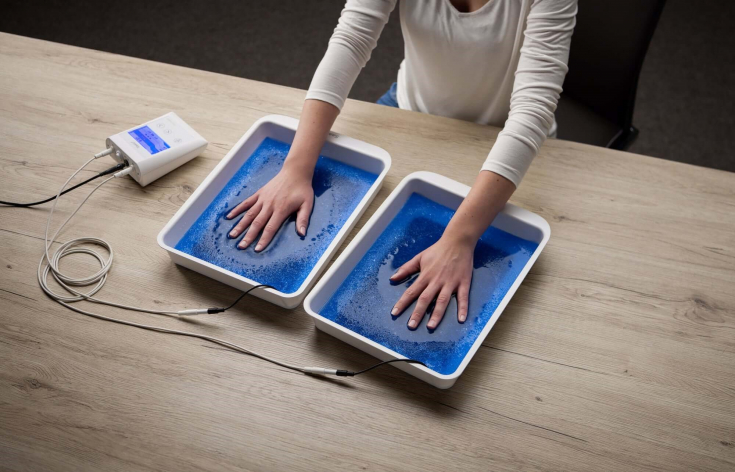Palmar hyperhidrosis is a therapeutic problem that significantly impairs the quality of life of patients with this pathology. For each patient, an individual "therapeutic ladder" is formed, paying attention to the severity of the disease, benefit-risk ratio,treatment cost, patient preference and specialist experience. Standard therapeutic approaches include topical, oral, and injectable preparations, as well as surgical correction techniques, which vary widely in terms of efficacy, safety, tolerability, and cost. In this review on estet-portalTopical antiperspirants for the treatment of palmar hyperhidrosis
- Iontophoresis for the correction of excessive sweating of the palms
Therapy of palmar hyperhidrosis with
botulinum toxin injections
- Topical antiperspirants for the treatment of palmar hyperhidrosis Topical antiperspirants aluminum chloride based are well established in the treatment of hyperhidrosis and are the first line of choice for all types of primary focal hyperhidrosis
, regardless of severity .
Read also: Primary hyperhidrosis: diagnostic and treatment methods The mechanism of action is blockade of the ducts of the eccrine sweat glands
with aluminum salts, which leads to functional and structural degeneration of the epithelial cells of the excretory ducts and secretory cells of the sweat gland, which ultimately prevents
sweat secretion. Follow us on
! In mild
cases, antiperspirants containing
zirconium aluminum trichlorohydrate may be effective. However, in moderate to severe cases, preparations containing Aluminum Chloride Hexahydrate at a concentration of 10-35% are recommended.
For best results, apply at night when palms sweat is minimal and leave on skin for 6-8 hours, after which – wash away.
After reaching euhidrosis, topical antiperspirants should be used 1-2 times a week or less often.
Iontophoresis for the correction of excessive sweating of the palms
Iontophoresis is the application of an electric current to enhance the transepidermal delivery of water
through intact skin immersed in a liquid.
Read also: Iontophoresis: the essence of the procedure, indications, contraindications Although the mechanisms of action
are not fully understood, it can be assumed that the therapeutic effect of iontophoresis in
hyperhidrosis of the palms is due to the blockade of the excretory ducts of the sweat glands due to hyperkeratinization, impaired transmission of nerve impulses by the sympathetic
nerve, decreased
pH due to precipitation of hydrogen ions, and impaired electrochemical sweat gradient. Follow us on Facebook! During iontophoresis, both hands are immersed in shallow trays of water.
At this time, a mild electrical current
15–20mA
15–40 minutes depending on the machine. There is currently no standard protocol established, so the procedure is initially performed
minutes depending on the machine. There is currently no standard protocol established, so the procedure is initially performed
until the desired effect is obtained.
Read also: Aspects of pain relief in the treatment of hyperhidrosis with botulinum toxin Typically, 6–15 initial sessions are required over 3 – 4 weeks. When euhidrosis
is achieved, patients switch to maintenance therapy -
once every 1–4 weeks. Therapy of palmar hyperhidrosis with botulinum toxin injections
Botulinum toxin type A, targeting the SNARE protein complex as a target, reversely blocks the release of acetylcholine
from presynaptic nerve endings, preventing sweat secretion by
«chemical denervation».
It is important to objectively determine
the exact area where the Minor starch-iodine test will be performed before treating hyperhidrosis of the palms with botulinum toxin injections. Read also: Hyperhidrosis of the palms and feet: causes, injection technique and features of botulinum toxin administration The optimal dilution of botulinum toxin in the palmar zone
is still under discussion, however concentrations of
onabotulinum toxin type A 1-2.5 units per 0.1 ml are widespread. The drug is administered intradermally in a volume of 0.1 to 0.2 ml per cm2.
Injection points should be evenly distributed in a grid pattern over the entire palmar surface (including fingers), given that each injection has a diffusion ring about 1″2 cm in diameter.
Generally, doses of 100–150 IU per arm are recommended depending on the response of the patient.
There is currently no consensus on the optimal dosing regimen for
BoNT-B. The anhydrotic
6–9 months .
.
"The Therapeutic Ladder
" excessive sweating of the palms usually begins with topical application of
antiperspirants, methods of choice in the absence of results are iontophoresis and injections of botulinum toxin
into the palmar area. In severe hyperhidrosis of the palms, all of the above methods can be simultaneously used to treat the disease in the first line and achieve
euhidrosis. More interesting stuff on our YouTube channel:







Add a comment